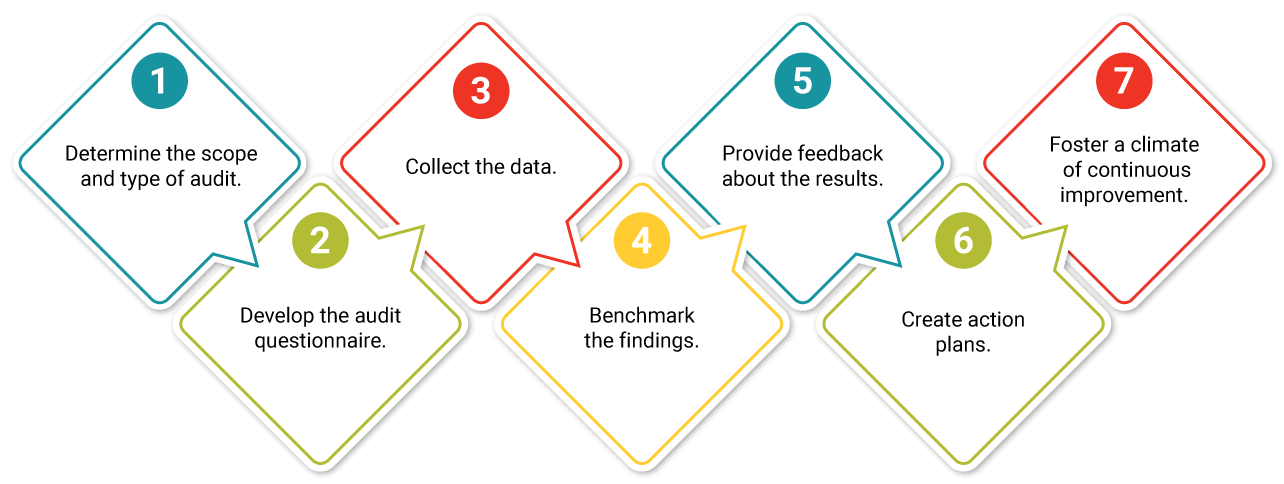HR Audit and Assessment
Objectively Evaluating your HR Practices

A regular HR audit and assessment is an effective way for any organization to get a clear sense of the current state of their HR policies and procedures. Laws, government regulations and HR best practices are constantly evolving, and your company’s HR policies and procedures need to evolve with them. However, no business can determine how their HR systems should evolve with the times without first understanding exactly where they stand in the present. An HR audit and assessment, conducted in an objective and data-driven format, is the best way to paint an accurate picture of the current status of your company’s HR practices in relation to today’s regulatory environment and the best practices that have been determined by research in the field.
Making HR Audits Comprehensive and Objective
For an HR audit and assessment to be useful, it needs to be as complete and objective as possible. Avoiding uncomfortable topics or critical judgement does not serve the long-term interests of the company involved. In fact, this kind of “soft-pedalling” or conflict avoidance actually prevents you from identifying the ways in which your organization is out of step with legal and regulatory requirements, as well as what research has shown to be the best approach to a variety of HR issues. When you don’t take a long and hard look at the “facts on the ground” in your business, you will miss out on the opportunity to improve your HR practices and procedures for the future.
The 7 Key Steps of an HR Audit
*Hover mouse below to view animated chart

Outside or Inside – What Works Best?
Many organizations attempt to conduct these HR appraisals with a completely internal team, dedicated to overseeing and executing an HR audit and assessment of their own organization. If your business has a well-staffed HR department full of qualified professionals, this is a natural decision to make. However, it may not be the best decision when it comes to generating the most thorough and objective results. Any individual or team, when tasked with documenting and analyzing their own or their team’s performance, is going to have a difficult time being objective. Differing perspectives, tangled relationships and personal feelings will invariable become involved, “muddying the waters” of your final conclusions and making the final product much less useful in its diagnostic purpose.

That’s why even companies with extensive internal HR resources are often much better off with tasking an outside entity to conduct their HR audit and assessment. The team at TPG HR Services has performed in this role for many organizations, producing objective and exhaustive reports, detailing all areas of HR policy and performance. Turning to an outside source such as TPG HR Services will almost always deliver the most useful and comprehensive information you need to make your company’s HR policies and procedures the best they can be in the years ahead.
Types of HR Audits
- Compliance Audits focus on how well the organization is complying with current federal, state, and local laws and regulations.
- Strategic Audits concentrate on how HR systems align with the company’s overall strategic plan.
- Best Practices Audits help an organization hone their competitive edge by comparing its HR policies and procedures with those of businesses recognized as cutting-edge in the field.
- Function-Specific Audits focus on a specific area in the HR function such as payroll, performance management, benefits administration to identify opportunities for improvement.
Areas of High Vulnerability
Although TPG HR Services typically conducts comprehensive and wide-ranging HR audits and assessments for our clients, we have identified specific areas that often lead to problems down the road for companies that leave them unaddressed. The following list enumerates some of these specific “problem areas” that often crop up when we conduct audits of our clients’ organizations. This list is not exhaustive, but it can serve as a guide to areas that all companies need to pay attention to when assessing the effectiveness of their HR systems and services. From our experience, particularly vulnerable areas include:
- Hiring & firing procedures
- Performance management techniques
- Employee discipline policies & execution
- Misclassifying of non-exempt jobs as exempt
- Missing or vague personnel files
- Illegal attendance policies
- Inaccurate time and attendance records
- Missing or incomplete I-9 forms

Uncovering and Addressing Issues Before They Emerge

The purpose of an HR audit and assessment is to identify issues and find solutions to problems before they become unmanageable. It is a chance to assess what an organization is doing right, as well as how it might do things more effectively, more efficiently or less expensively. When it comes to issues related to compliance, HR audits can perform a literally life-saving role for organizations, helping them to avoid the devastating legal and financial consequences that unaddressed compliance issues can have on a company’s bottom line. It is an unfortunate reality that organizations who do not conduct regular HR audits and assessments only become aware in retrospect of the monetary costs of ignoring HR-related legal quagmires. Noncompliance with appropriate laws and regulations involves significant financial risk to an organization, and a well-conducted HR audit can save a business from potential financial ruin. These are the sorts of issues that you want to identify early, before they emerge into messy public and legal entanglements. An HR audit and assessment, conducted by a highly-skilled team like that at TPG HR Services can save your organization for untold damage and expense in the years ahead.
The first step toward implementing world-class HR policies and practices is to objectively identify your starting point today. Let the experienced team at TPG HR Services independently audit and assess the current state of your company’s HR environment and help you design HR systems that will serve your needs in the years to come.

